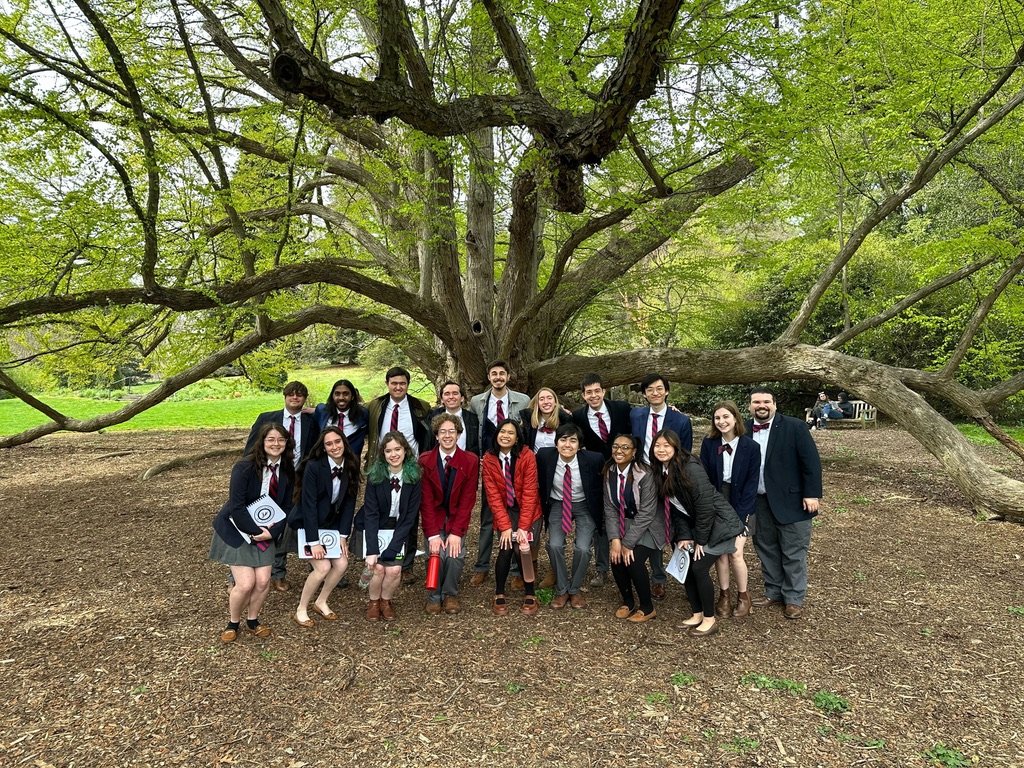
A 160-Year-Old Tradition.
The University of Pennsylvania Glee Club began modestly on November 5, 1862, when eight undergraduate men formed the Club, making it the oldest performing arts group at the University. Later that year, the Glee Club held its first performance in the old Collegiate Hall at 9th and Chestnut Streets for “an audience that was unusually select and large, the Hall filled to its utmost capacity.” At this concert, each member wore a red and blue ribbon through their lapel, making the Club the first group to wear the University’s colors as part of its uniform.
Within ten years, the University was home to three separate glee clubs, each of which represented a graduating class, but in 1880, those clubs reunified as one Glee Club. When Houston Hall opened in 1896, the Glee Club was given a room to share with the Banjo Club; four years later, in 1900, the Glee, Banjo, and Mandolin Clubs all merged to become the Combined Musical Clubs.
In 1917, Winifred Waldie Webb founded the Women’s Penn Glee Club, which was a separate organization from the Men’s Glee Club. Its first performance was on April 20, 1917. As World War I drew to a close, the Men’s Glee Club, like most groups on campus, suspended activities in the fall of 1918 due to mandatory military training. The Men’s and Women’s Glee Clubs would eventually perform together, with their first joint concert happening on April 5, 1920.
On February 9, 1926, the Glee Club performed at the White House for President Calvin Coolidge, and for the next four years, the Men’s and Women’s Glee Clubs enjoyed numerous joint performances. Especially of note was the1928 production, Hades, Inc., the Clubs’ first original staged show. That same year saw the separation of the Men’s Glee Club from the Combined Musical Clubs; at its height, the Glee Club boasted 150 members.
Beginning in 1934, the Men’s Glee Club performed at least once a year with the Philadelphia Orchestra, including a 1938 performance of Johannes Brahms’ Alto Rhapsody with Marian Anderson; Anderson would later go on to receive the Glee Club’s Award of Merit in 1973. In 1950, the Penn Pipers, an a cappella subset of the Glee Club, was founded, making it one of Penn’s oldest a cappella groups.
In 1956, Edie Saltzberg (née Herman) and Meryl Ettelson were the first two female-identifying members of the Glee Club; both joined as accompanists. One year later, in 1957, Saltzberg was a founding member of the Penn Syngers, a rebranding of the Women’s Glee Club. In 1959, the Men’s Glee Club had its first performance tour outside of the contiguous United States when it traveled to Puerto Rico.
The 1960s were a formative decade for the Penn Glee Club. In 1962, Bruce Montgomery, the Director of the Glee Club from 1956–2000, was commissioned by NBC to set Abraham Lincoln’s Gettysburg Address to music to commemorate the 100th anniversary of the speech the following year. “Monty” also composed and arranged many of the Club’s core repertoire, including its anthem, “Afterglow,” in this same timeframe. The year 1964 also saw the creation of the Glee Club Award of Merit, which honors an individual that has “made a significant contribution to the world of music and helped to create a climate in which our talents may find valid expression”; four years later, in 1968, the Penn Glee Club first awarded honorary membership to individuals who have demonstrated consistent devotion to and support of the Glee Club, well beyond the norm.
Perhaps most importantly, in 1969, the Glee Club made theatrical showmanship standard fare with the creation of the Penn Glee Club Spring Show, a fully staged, Broadway-style production. The Glee Club’s 1971 Spring Show, Paint the Red Town, was the inaugural performance in the recently opened Zellerbach Theatre; the Club still performs there to this day.
In 1989, the Pennchants were founded as a small group of the larger Glee Club; it would become a separate group in 2001. By 1993, the Penn Glee Club accepted all genders in its accompanist, technical, and band sections, though the choir remained open only to male tenors and basses. In 2002, the Club collaborated for the first time with Penn Dance Company for its Fall Show, a collaboration that continues to this day. In 2008, technical members were eligible for full membership for the first time, though they had to complete a year-long associate membership process first. In 2009, the Penn Glee Club Band was formally constituted, though its members also had to complete a year-long associate membership process first.
In the 2011–2012 season, the Glee Club celebrated its 150th anniversary with the “Year of Glee,” which culminated in a joint Club-alumni concert in February 2012. As the oldest performing arts group at Penn, the Glee Club boasts an extensive alumni network, affectionately referred to as the Glee Club Graduate Club, that includes ambassadors, Broadway executives, and medical professionals. That year also saw the removal of associate membership for band members; technical members still had to undergo associate membership until 2015.
On April 9, 2021, following several years of discussion, numerous surveys and calls, and a year of careful deliberation, the Penn Glee Club finally voted to merge with its sister group, the Penn Sirens, and to remove the gender restriction on singing membership, making the Club fully gender-inclusive for the first time in its history. The Club now features an SATB choir along with SSAA and TTBB chamber choirs.
The modern Club is a reflection of its rich heritage and its contemporary character. Now in its 163rd season, the University of Pennsylvania Glee Club remains, as former Pennsylvania Governor Milton Shapp once remarked, “one of the finest musical organizations in existence.” It proudly represents the University in its grand tradition and is equally proud to preserve its distinctive blend of choral excellence and theatrical showmanship, the hallmark of the Penn Glee Club.
The 1868–1869 roster of the University of Pennsylvania Glee Club.
The combined Men’s and Women’s Glee Clubs’ 1928 production of Hades, Inc.
A still from our 1977 Spring Show, Extravagancelot.
The combined Club-alumni choir performs for the Glee Club’s 150th anniversary.
The 2022–2023 Penn Glee Club at its annual performance at the Morris Arboretum.




